Jane Davies is a full time artist working in collage, painting, mixed media and encaustics. She offers workshops at her studio and nationwide, focusing on helping people to find a personal and playful approach to creating. She is the author of several books, including
Collage Journeys: A Practical Guide to Creating Personal Artwork and
Adventures in Mixed Media: Collage, Stitch, Fuse, and Journal Your Way to a More Creative Life. We caught up with Jane to ask her about her work and her creative inspirations.
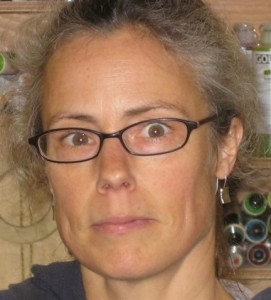 You started out as a potter. What made you decide to start collage?
You started out as a potter. What made you decide to start collage?
While I was a potter selling at craft shows, I had a couple of quiet months each winter to go off on a tangent and do my own thing. For a few years I spent that time exploring fine art – painting, collage, printmaking and related techniques. It was Gerald Brommer’s book,
Collage Techniques, that first inspired me to really delve into collage, sometime in the late ‘90’s.
You also do bookbinding, printmaking, weaving, beading, just to name a few. Is there any medium you haven’t explored yet that you want to try?
I am definitely in the category of “jack-of-all-master-of-none.” It does not seem to be in my nature to home in on one medium and exploit its expressive possibilities to the Nth degree. That would certainly make my studio set-up a lot simpler! Is there anything I haven’t tried that I would like to? Of course! But my current obsession is encaustics, and I can’t seem to look beyond that at the moment.
Have you being making art your whole life?
No. I made art as a kid, and then I stopped in my teen years. I tried art in college, but it was too hard, too open-ended. WHAT WAS I THINKING???!! I think I got too self-conscious, too insecure about my own taste and abilities. I slowly came into art-making through pottery – it seemed sort of safe, as there are a lot of rules and parameters to making functional dishes. And then I did freelance art, licensing my work to manufacturers. This was much less constricting than production pottery, but still very much directed. It has taken me my whole adult life to finally Make Art that is just my own and not
for something. So, to answer your question, I’ve been making art my whole adult life, but I feel that my collage/painting is a new chapter.
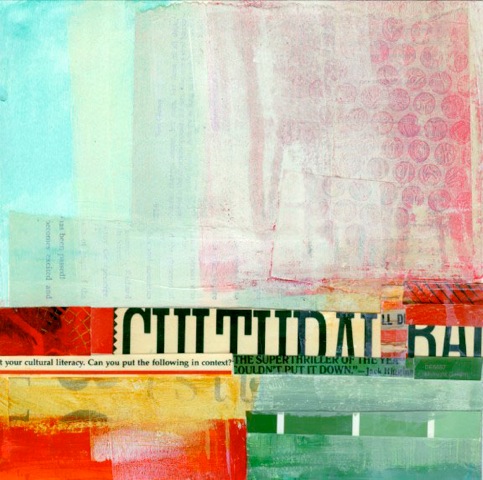
Cultural Literacy 2
Can I quote myself? From the epilogue of Collage Journeys: “If you knew the destination in advance, the journey would be more like a commute, rather than the meandering, inquisitive route that makes collage so rich with possibility”. I call it a journey because it suggests that you don’t necessarily know the outcome, and you are paying attention to whatever comes up along the way. “The collage journey brings you to many forks in the road where you have to reflect on where you’ve been and decide where you are going. But along the way you can enjoy the scenery.”
Collage is often full of personal metaphors and symbols. Do you find certain motifs or symbols reoccurring in your work?
I’m not sure. Sometimes that is the sort of thing that is more obvious to someone who is not the artist. I do keep coming back to the grid format, and I tend towards vary basic shapes – circles, donuts, squares. In earlier work I used more maps, sea imagery, more specific references, but now it is the abstract elements that drive me. I would welcome the coming together of the two – abstract and referential – and maybe it will if I give it a little nudge. This is not the sort of thing I can force.
Teaching a form of personal expression like art must be challenging. How do you balance technique with inspiration and free will?
Very insightful question! Indeed, teaching, like making art and most other things, is a balancing act! I try to design workshops so that each student’s work will have very individual results. The goal is to give enough technique instruction and enough format direction so a student has a starting point. But then there has to be enough open-endedness so real exploration is possible. If it’s just “do this, this, and this, and make work like mine, or like the example”, then I don’t feel I’m teaching the important stuff. In a workshop setting I try to give enough individual attention to fine-tune the amount of direction I give for a project. Some people want more rules, some want more freedom, and it is important to honor that.
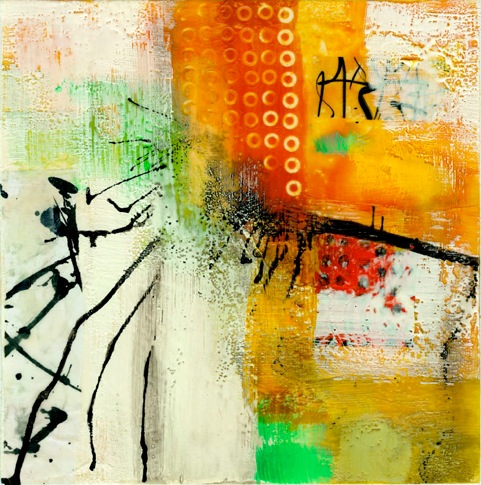
You’re part of an interesting project called The Sketchbook Challenge. Could you tell us a little more about that?
The Sketchbook Challenge is the brainchild of Sue Bleiweiss, who continues to be the driving force of this project. She put together a group of artists who want to promote the idea of using your sketchbook on a regular basis. Each month one of us posts a theme, and readers are encouraged to work in their sketchbooks and post their pages on our group
Flickr site. We offer tutorials and tips, post our own sketchbook pages, share our struggles and discoveries, post interviews with artists and blog readers, and generally try to be a
free resource for people who want a little inspiration, instruction, or encouragement for their art practice.
Do you have favorites among your work? Could you tell us about one or two of them. Why are they special?
Usually my favorite work is the current work, though I do have favorites among my older pieces. Among my current work in encaustic one of my favorites is my self-portrait. I have only ever done self-portraits in my sketchbook, as studies of a certain technique, or explorations of process or drawing practice. This is the first self-portrait I have done as a finished piece. It is 8”x8”, encaustic and collage on wood panel.
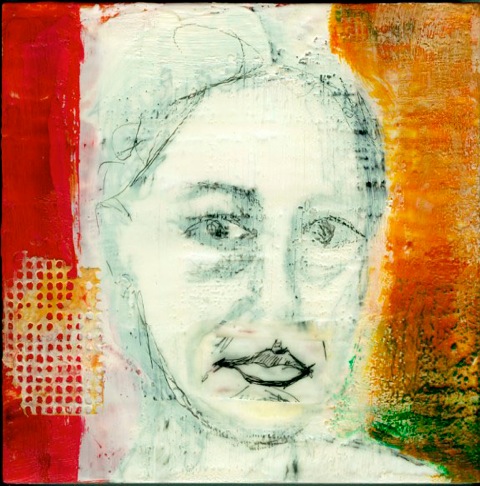
Among less recent works, the following collage-painting is one of my favorites because it is one of the first I did in this mode of layering collage and paint that I was happy with. I like its mysterious depth.
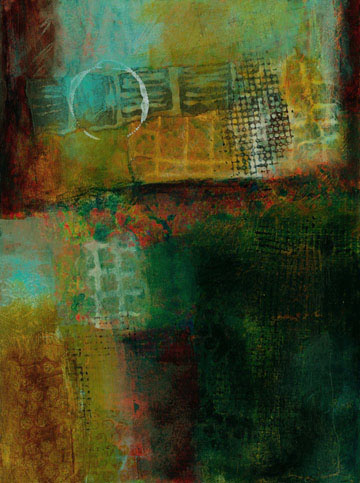
This piece has been in a couple of shows, but remains in my collection and hangs on my studio wall.
I did a group of work in 2010 inspired by the illustrations of Katherine Dunn, in terms of format and materials. This one, Tree on River, is my favorite from that group. It tends towards the representational more than most of my work, and I loved using the magazine papers to add depth.
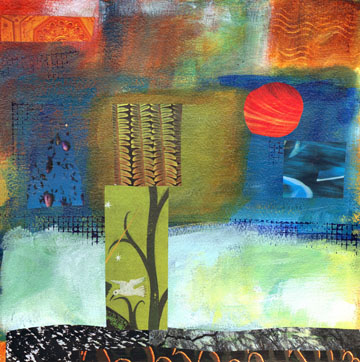 You’re certainly a creative person. What do you think being artistic adds to your life?
Adds
You’re certainly a creative person. What do you think being artistic adds to your life?
Adds to my life? It
is my life! I can tell you what it
subtracts from my life: the possibility of ever having a boring job or a job that I don’t like, and the possibility of a regular or dependable paycheck. As an artist making a living from my work I have had to, or chosen to, reinvent my career a number of times, so the whole career has been a constant work-in-progress. Sometimes I would like to feel as if I have
arrived somewhere, but it keeps on being a journey. (As a potter, I had definitely arrived at a relatively predictable and stable place, and guess what? I got bored and moved on!) I think that may just be part of choosing a life that has creativity as its center.
What advice would you offer a person who wanted to start working in collage?
Get a few books (I still would highly recommend Gerald Brommer’s book mentioned earlier), and dive in. And don’t limit yourself to collage! Try everything.
You need to
login to comment.